Lunar Delights and Other Bright Sights, Speedy Mercury Moves towards Venus, and Mars Parties with Jupiter in Morning!
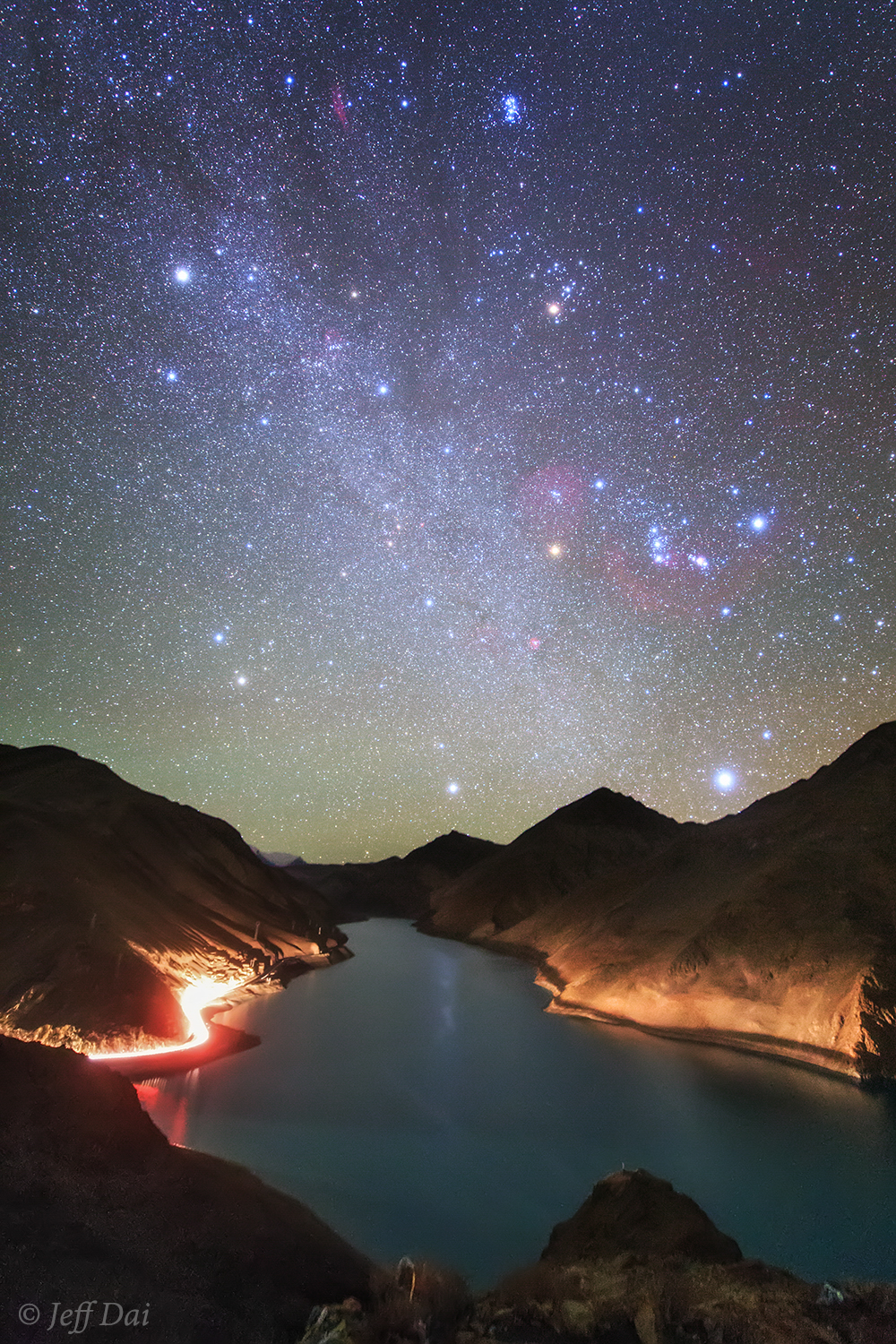
This image of the Winter Hexagon / Football was taken by Jeff Dai. Start with bright Sirius just above the hills at lower right, then head straight up to Rigel, and to the upper left to reddish Betelgeuse, and then bright yellow Capella on the left. Next head down to Castor and Pollux, and finally towards Procyon at bottom centre, and back to Sirius.
Hello, Groundhog Day Stargazers!
Here are your Astronomy Skylights for the week of February 2nd, 2020 by Chris Vaughan. Feel free to pass this along to your friends and send me your comments, questions, and suggested topics. I repost these emails with photos at http://astrogeo.ca/skylights/ where all the old editions will be archived. You can also follow me on Twitter as @astrogeoguy! Unless otherwise noted, all times are Eastern Time. To subscribe to these emails please click this MailChimp link.
I can bring my Digital Starlab portable inflatable planetarium to your school or other daytime or evening event. Contact me through AstroGeo.ca, and we’ll tour the Universe together!
The moon will dominate evening skies the world over this week as it transitions between first quarter and full, so we’ll take a look at some lunar delights – and also at some bright sky objects like Sirius and the Winter Football. Mercury will climb to join Venus in the western evening sky, and Mars will move towards Jupiter in the pre-dawn east. Here are your Skylights!
The Moon this Week
This is the week of the lunar month when the moon might catch your eye in the afternoon daytime sky all around the world. Then it will stick around to shine brightly in your evening sky while it waxes toward full on the coming weekend.
Tonight (Sunday), the slightly more than half-illuminated moon will sit below the bright little Pleiades star cluster in Taurus (the Bull). On Monday evening the orbital motion of the moon will carry it along the upper (northern) edge of the triangle of stars that make up the face of the bull. After dusk, Taurus’ triangle of stars will be positioned just below the moon. At approximately 12:30 am EST, the moon will pass very close indeed to the medium-bright star Epsilon (ε) Tauri, which marks the bull’s northern eye. By that time, the movement of the sky due to Earth’s rotation will have tipped the bull upright, and the moon will be tucked inside the upper right corner of the triangle. Observers who live in southerly latitudes can actually watch the moon pass in front of (or occult) that star for about an hour.
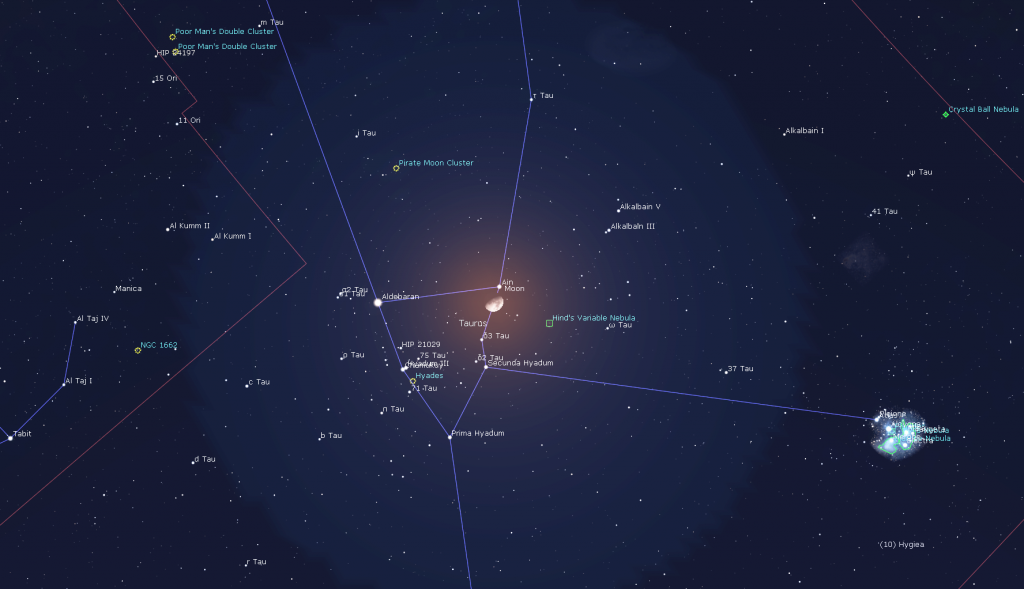
By Wednesday night, the moon will have moved east to tickle the toe stars of Castor, Gemini’s westerly twin. That night, the moon will be surrounded by a collection of spectacular deep sky objects, including the bright, open star cluster named Messier 35, which will sit a thumb’s width above (or 1.5 degrees to the celestial northwest of) the moon. Your binoculars might pick up the cluster’s stars that night – but a better bet would be to note the cluster’s location and return for a look on a night when the moon has left the scene.
Before the nearly-full moon sets in the west before dawn on Saturday morning, it will be sliding through the upper (northern) edge of another large open star cluster known as The Beehive (or Messier 44 and M44) in the constellation of Cancer (the Crab). These encounters between the moon and the bees occur frequently because the cluster is located only one degree north of the ecliptic. The moon and the cluster will both fit within the field of view of your binoculars or your telescope when using a low magnification eyepiece – but the moon’s brilliance will mostly overwhelm the clusters’ stars. To see more cluster stars, try hiding the moon just outside of your optics’ field of view.
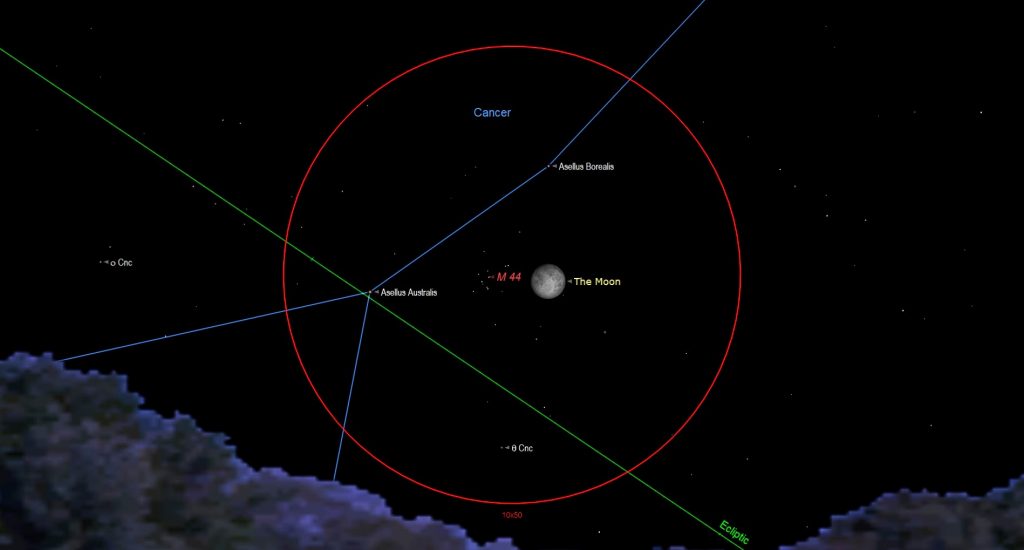
We end this week with the February full moon. It will officially occur during the wee hours of Sunday in the Eastern Time zone (or at 7:33 Greenwich Mean Time) – so the moon will look completely full on Saturday evening and slightly less than full on Sunday evening. At full, the moon always rises around sunset and set around sunrise because it is opposite the sun. The February full moon always shines in or near the stars of Leo (the Lion), which is half the sky away from the sun in the stars of Capricornus (the Sea-Goat). This full moon happens to occur 1.5 days before perigee, the point in the moon’s orbit when it is closest to Earth, making this almost, but not quite, a supermoon. A trio of genuine supermoons will occur from March to May, with March’s being the largest full moon of 2020.
Every culture around the world has developed its own set of stories for the moon, and every month’s full moon now has one or more nick-names. The indigenous Ojibwe people of the Great Lakes region call the February full moon Namebini-giizis “Sucker Fish Moon” or Mikwa-giizis, the “Bear Moon”. For them it signifies a time to discover how to see beyond reality and to communicate through energy rather than sound. The Cree of North America call it Kisipisim, the “the Great Moon”, a time when the animals remain hidden away and traps are empty. For Europeans, it is known as the Snow Moon or Hunger Moon.
Looking at the moon through binoculars and telescopes this week will show you the tremendous difference in the way sunlight illuminates the moon, and the impact of that. Early in the week, the sun’s rays will be striking the moon from the side – especially along the pole-to-pole terminator line that separates the lit and dark hemispheres where the sun is just rising over the moon’s eastern horizon. With no atmosphere to scatter light, the shadows cast by every crater rim, mountain, and ridge are a deep black – and even very small bumps and ridges are highlighted, revealing otherwise hidden features on crater floors.
During the coming weekend, however, the moon will be fully illuminated, and the light striking the moon then will be coming from directly “behind you” when you face the full moon – the same way the projector in a cinema lights up the movie screen in front of you. That sunlight is arriving straight-on to the moon’s surface, so it doesn’t generate any shadows. Every variation in brightness and colour you see on a full moon is due entirely to the moon’s geology, not its topography! Now you can easily distinguish the dark, grey basalt rocks from the bright, white aluminum-rich anorthosite rocks.
The basalts overlay the various lunar maria, Latin for “seas” – coined because people used to think they were water-filled. The maria are basins excavated by major impactors early in the moon’s geologic history and later infilled with dark basaltic rock that upwelled from the interior of the moon late in the moon’s geological history.

The much older and brighter parts of the moon are composed of anorthosite rock. Those areas are higher in elevation and are heavily cratered – because there is no wind and water, or plate tectonics, to erase the scars of impacts. By the way, the bright, white appearance is produced by sunlight reflecting off of the crystals the rock is made of – the same sort of crystals you see in the granite countertops in Earth’s kitchens. And yes, there are coloured rocks on the moon.
Some of the violent impacts that created the craters in the highland regions also threw bright streams of ejected material far outward and onto the darker maria. We call those streaks lunar rays. Some rays are thousands of km in length – like the ones from the very bright Tycho crater in the moon’s southern central region.
Use your binoculars to scan around the full moon. There are smaller ray systems everywhere! There are also places where craters punched into the maria have ejected dark rays on to white rocks. And, since the dark basalt overlays the white, older rock below, you can find lots of craters where a hole has been punched through the dark rock, producing a white-bottomed crater!
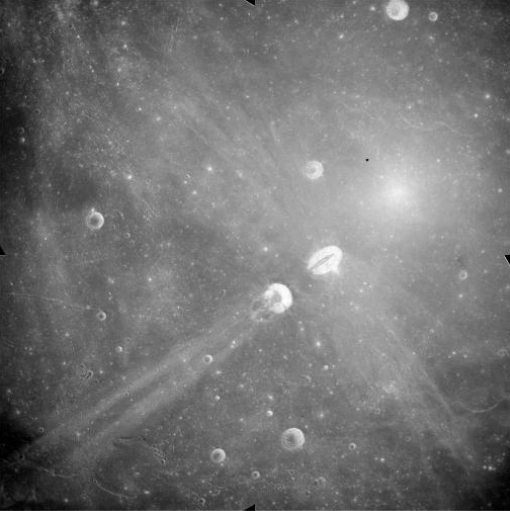
Several of the maria link together to form a curving chain across the northern half of the moon’s near-side. Mare Tranquillitatis, where humankind first walked upon the moon, is the large, round mare in the centre of the chain. Sharp-eyes might detect that this mare is darker and bluer than the others, due to enrichment in the mineral titanium. That’s one of the reasons why Apollo 11 was sent there.
Super(bowl) Targets
Here are a few suggestions for your evening viewing this week, including a Superbowl connection.
First up, the night sky’s brightest star Sirius, or Alpha Canis Majoris, reaches its highest point around 10 pm local time. Sirius is a hot, white A-class star located only 8.6 light-years from Earth – part of the reason for its bright appearance. For mid-northern latitude observers, Sirius is always seen in the lower third of the sky, through a thicker blanket of refracting atmosphere. This produces the strong twinkling and flashes of color the Dog Star is known for.
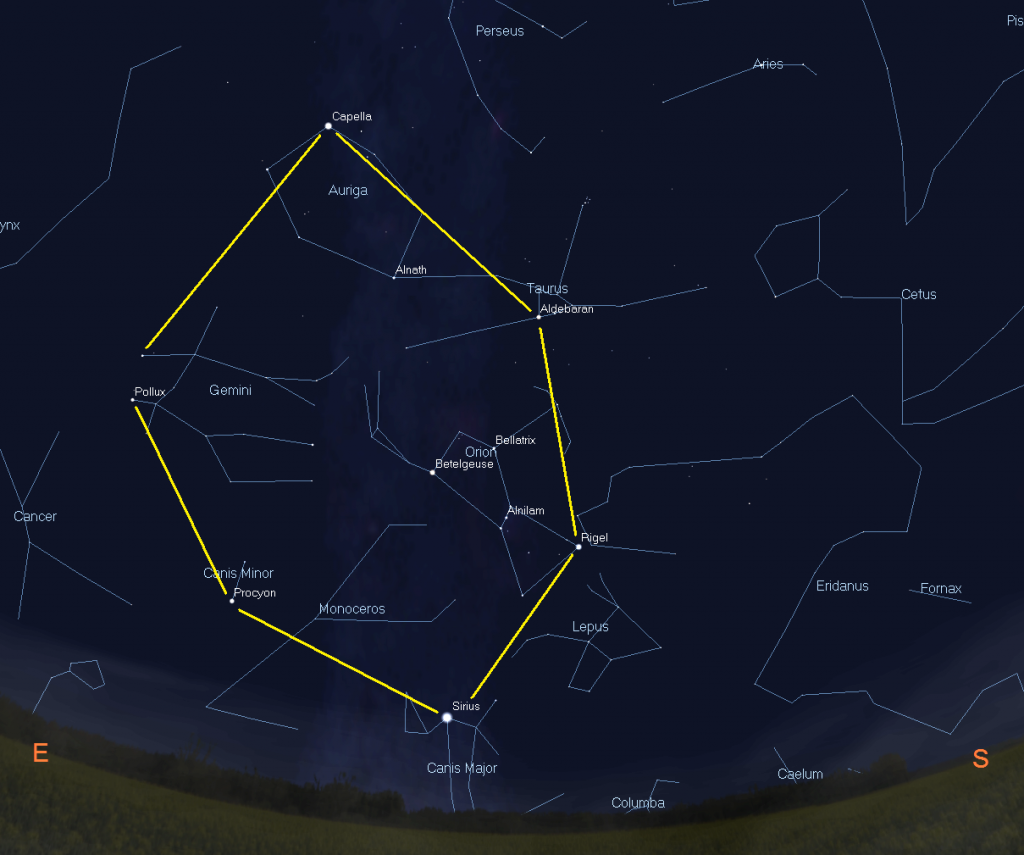
Next up, you can trace out the bright stars forming the gigantic football-shaped Winter Foorball asterism – just by standing outside and looking south on a clear evening! The Winter Football, also known as the Winter Hexagon and Winter Circle, is an asterism composed of the brightest stars in the constellations of Canis Major, Orion, Taurus, Auriga, Gemini, and Canis Minor. After dusk, the huge star pattern will stand upright in the southeastern sky, extending from about 20 degrees above the horizon to nearly overhead.
Start by facing southeast and find the extremely bright star Sirius sitting low over the horizon. From there, look 2.5 fist diameters to Sirius’ upper right (or 25 degrees to the celestial northwest) for bluish Rigel. Look well above Rigel for orange-coloured Aldebaran, and then continue to Aldebaran’s upper left to yellowish Capella at the top of the asterism (and nearly overhead). To identify the stars that form the football’s left (eastern) side, look lower and to the left (or celestial southeast) of Capella for the bright, matched pair of stars Castor and Pollux in Gemini (the Twins). One twin will be a few finger widths higher than the other. The very bright, white star Procyon sits two fist diameters below those twins – and we complete the football by returning to Sirius.
The Milky Way passes vertically through the Winter Football. Its football-shape is visible during evenings from mid-November to spring every year. The waxing gibbous moon will travel directly through the asterism from Tuesday through Thursday this week.
In early evening during early February, the constellation of Perseus (the Hero) is positioned nearly overhead in the northern sky. A very large open star cluster designated Melotte 20 surrounds Perseus’ brightest star Mirfak, which is also called Alpha Persei. The cluster is also known as the Alpha Persei Moving Group and the Perseus OB3 Association. It consists of about 100 young, massive, hot B- and A-class stars spanning 3 degrees (or 6 full moon diameters) of the sky! Melotte 20 can be seen with unaided eyes, but it really pops in binoculars and telescopes at very low magnification. The cluster is approximately 600 light years from the sun and is moving through our galaxy as a group. The star Mirfak is an elderly yellow supergiant that has evolved out of its blue phase and it is now fusing helium into carbon and oxygen in its core. It is moving with them.

The constellation of Auriga (the Charioteer) occupies a position high in the eastern sky during evening. The Milky Way passes directly through Auriga, so that part of the sky is rich in open star clusters that are visible with unaided eyes from dark sky locations – and binoculars and telescopes will readily show them in moderately light-polluted skies. The bright clusters named Messier 38, Messier 36, and Messier 37 form a downward curving chain that starts a fist’s diameter to the right of the constellation’s brightest star, Capella.
You’ll want to seek out those clusters on a night with less moonlight (such as next week and the week after that). For now, focus on Capella itself. It’s a very bright (magnitude 0.05), yellow sun-like star, sixth brightest in the entire night sky, and is located only 42 light-years from Earth. Capella’s nick-name is the Goat Star. A few finger widths to its lower right (or several degrees south of it), look for a narrow triangle of three dim stars known as the Kids – Almaaz, Heodus, and Saclateni. The shape of Auriga resembles a rough ellipse, although the medium-bright star at its south end, named Elnath, is actually one of the horn-tip stars of Taurus (the Bull).
Even during this very moon-filled week, don’t forget to keep an eye on reddish Betelgeuse in Orion (the Hunter). It’s still experiencing that unusual dimming I’ve been describing recently.
Finally, if you are outside late in the evening, look for the “super-bright”, orange-ish star Arcturus sitting low over the northeastern horizon. That star’s appearance in the evening hours signals that spring will soon be here!
The Planets
Mercury is putting on a fantastic evening appearance for equatorial and Northern Hemisphere observers. It will reach peak visibility on February 10 – but you can see it easily this week for a while after dusk. Look a palm’s width above the west-southwestern horizon after sunset. Mercury will climb higher every day, so keep trying on every clear evening. This week, the optimal viewing time for Mercury will be between 6 pm and 6:30 pm local time. Mercury can be easily seen with unaided eyes in a cloud-free sky. If you use binoculars to hunt for Mercury, make sure that the sun has already completely sunk out of sight first.
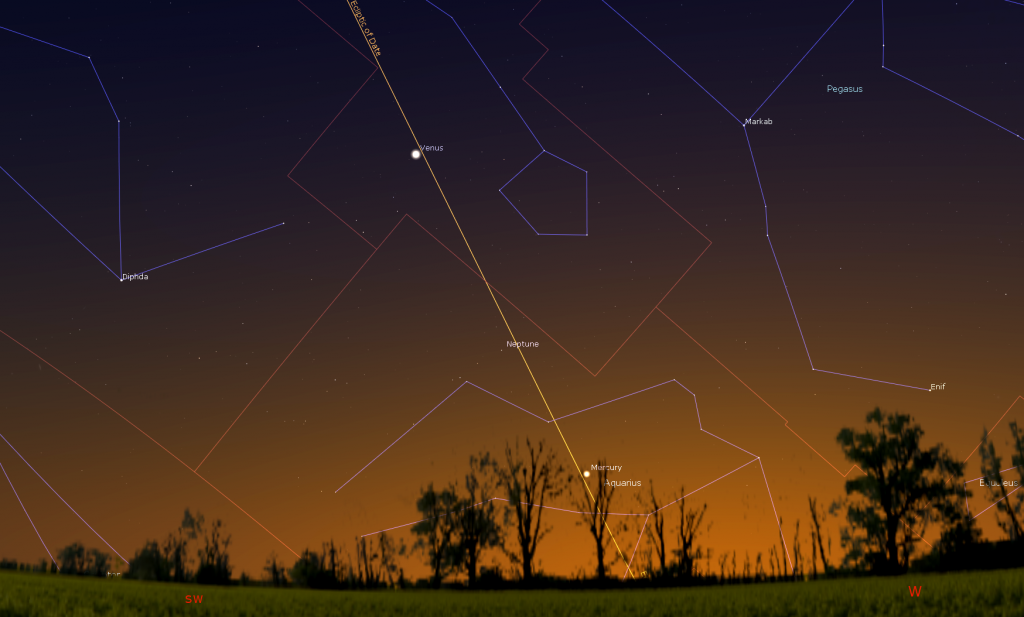
That incredibly bright “star” that you’ve been seeing in the southwestern sky every evening recently is Venus, the queen of the night this winter. She’ll hold court in the western evening sky until spring. This week, Venus will set in the west at about 9 pm local time. If you want to see Venus’ less-than-fully-illuminated disk in your telescope, try to view it as soon as you can find it, when Venus is higher in the sky. Then you’ll be viewing the planet through less of Earth’s distorting atmosphere.
Distant and dim Neptune is sitting between Venus and Mercury in the western sky – but that planet is too difficult to observe when it’s that low in the sky. The only other observable evening planet nowadays is Uranus. The blue-green planet is observable from dusk until late evening (it sets at about 12:15 am local time). Uranus is located a generous palm’s width above (or 7° to the celestial east of) the modest stars that form the V-shaped constellation of Pisces (the Fishes). Uranus is actually located within the boundary of Aries (the Ram) – and is positioned below (or to the celestial south of) that constellation’s brightest stars, Sheratan (the lower, more westerly star) and Hamal (the higher, more easterly star). The planet is also a fist’s diameter to the upper right of the ring of stars that form the head of Cetus (the Sea-Monster).

Shining at magnitude 5.8, Uranus is bright enough to see under dark sky conditions with unaided eyes and with binoculars – or through small telescopes under less-dark conditions. To help you find it, I posted a detailed star chart here. If you view Uranus after about 6:30 pm local time, it will be higher, in the dark, southern sky – and you’ll be looking through the least amount of Earth’s disturbing atmosphere. The main belt asteroid Vesta is near Uranus recently – just above the Sea-Monster’s head. Use binoculars to look for that magnitude 7.9 object.
Mars is starting to increase in brightness as Earth moves towards it ahead of October’s big Mars showing. The red planet will continue to shine in the southeastern pre-dawn sky this week, where it will remain for months to come. This week, Mars will rise at about 4:15 am local time and remain visible until dawn. The relative positions and combined orbital motions of Earth and Mars are causing Mars to appear in roughly the same place in the sky at the same time every morning. However, the planet is actually moving rapidly eastward in front of the distant background stars because they rise four minutes earlier every morning – while Mars does not.

This week, Mars will skim across the foot of Ophiuchus (the Snake-Bearer). Mars’ stellar rival, the bright, ruddy-tinted star Antares will be sitting 1.5 fist diameters to Mars’ upper right. That star marks the heart of Scorpius (the Scorpion).
Finally, if your southeastern horizon is low and free of obstacles, try and spot very bright Jupiter from 6:30 am local time to dawn. Saturn is there, too – but it’s too soon to look for it.
Binocular Comet Update
I’ll update you on comet C/2017 T2 (PanSTARRS) next week, when the bright moonlight will be less intrusive. This comet is expected to brighten much more in the coming months. Stay tuned for updates!
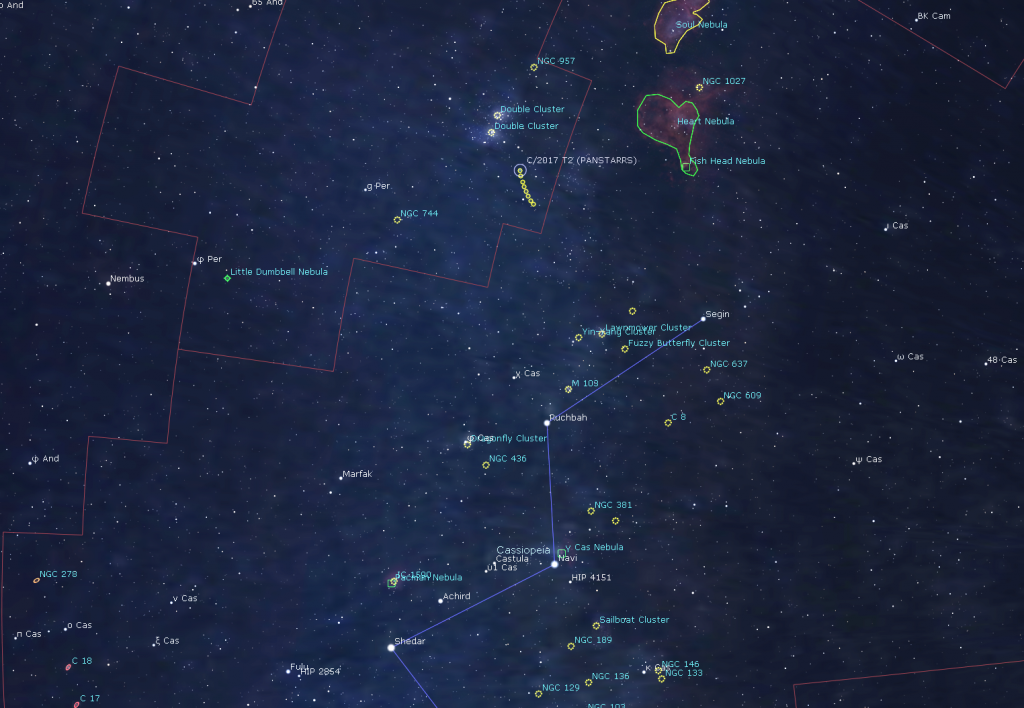
Public Astro-Themed Events
Every Monday evening, York University’s Allan I. Carswell Observatory runs an online star party – broadcasting views from four telescopes/cameras, answering viewer questions, and taking requests! Details are here. On Wednesday nights they offer free public viewing through their rooftop telescopes, including their brand new 1-metre telescope! If it’s cloudy, the astronomers give tours and presentations. Registration and details are here.
On Wednesday evening, February 5 at 7 pm, the Perimeter Institute in Waterloo will present Warp Drives and Aliens, a free public talk and webcast about interstellar travel and alien life. The speaker is Bryan Gaensler, Director of the Dunlap Institute for Astronomy and Astrophysics at the University of Toronto. Registration and details are here.
On Thursday, February 6 at 6:30 pm at Humber Bay Library, University of Toronto Emeritus Professor of Astronomy John Percy will present a free public talk entitled The Amazing Universe. Details are here.
On Thursday, February 6 at 8 pm in the Royal Canadian Legion in Hamilton, the RASC Hamilton Centre will present a free public talk by Dr. Laura Parker of McMaster University entitled Galaxy Evolution in Groups and Clusters. Details are here.
On Thursday, February 6, starting at 9 pm, U of T’s AstroTour will present the public lecture Dark energy: The weirdest 70% of the Universe by Pavel Motloch, a Postdoctoral Fellow at the Canadian Institute for Theoretical Astrophysics. Stargazing will follow (weather permitting). Details are here.
If it’s sunny on Saturday morning, February 8 from 10 am to noon, astronomers from the RASC Toronto Centre will be setting up outside the main doors of the Ontario Science Centre for Solar Observing. Come and see the Sun in detail through special equipment designed to view it safely. This is a free event (details here), but parking and admission fees inside the Science Centre will still apply. Check the RASC Toronto Centre website or their Facebook page for the Go or No-Go notification.
On Sunday, February 9 from 11 am to 4 pm, the Ontario Science Centre will celebrate International Day of Women and Girls in Science with a variety of activities and talks to inspire girls and young women to pursue science. It’s free with regular OSC admission. Details are here.
This winter, spend a Sunday afternoon in the other dome at the David Dunlap Observatory! On Sunday, February 9, from noon to 4 pm, join me in my Starlab Digital Planetarium for an interactive journey through the Universe at DDO. We’ll tour the night sky and see close-up views of galaxies, nebulas, and star clusters, view our Solar System’s planets and alien exo-planets, land on the moon, Mars – and the Sun, travel home to Earth from the edge of the Universe, hear indigenous starlore, and watch immersive fulldome movies! Ask me your burning questions, and see the answers in a planetarium setting – or sit back and soak it all in. Sessions run continuously between noon and 2 pm, and repeat from 2 to 4 pm. Ticket-holders may arrive any time during the program. The program is suitable for ages 3 and older. The Starlab planetarium is wheelchair accessible, but everyone else sits at floor level. For tickets, please use this link. Tickets for future dates will be available soon.
Keep looking up, and enjoy the sky when you do. I love questions and requests. Send me some!